#Data science project based training
Explore tagged Tumblr posts
Text
Margaret Mitchell is a pioneer when it comes to testing generative AI tools for bias. She founded the Ethical AI team at Google, alongside another well-known researcher, Timnit Gebru, before they were later both fired from the company. She now works as the AI ethics leader at Hugging Face, a software startup focused on open source tools.
We spoke about a new dataset she helped create to test how AI models continue perpetuating stereotypes. Unlike most bias-mitigation efforts that prioritize English, this dataset is malleable, with human translations for testing a wider breadth of languages and cultures. You probably already know that AI often presents a flattened view of humans, but you might not realize how these issues can be made even more extreme when the outputs are no longer generated in English.
My conversation with Mitchell has been edited for length and clarity.
Reece Rogers: What is this new dataset, called SHADES, designed to do, and how did it come together?
Margaret Mitchell: It's designed to help with evaluation and analysis, coming about from the BigScience project. About four years ago, there was this massive international effort, where researchers all over the world came together to train the first open large language model. By fully open, I mean the training data is open as well as the model.
Hugging Face played a key role in keeping it moving forward and providing things like compute. Institutions all over the world were paying people as well while they worked on parts of this project. The model we put out was called Bloom, and it really was the dawn of this idea of “open science.”
We had a bunch of working groups to focus on different aspects, and one of the working groups that I was tangentially involved with was looking at evaluation. It turned out that doing societal impact evaluations well was massively complicated—more complicated than training the model.
We had this idea of an evaluation dataset called SHADES, inspired by Gender Shades, where you could have things that are exactly comparable, except for the change in some characteristic. Gender Shades was looking at gender and skin tone. Our work looks at different kinds of bias types and swapping amongst some identity characteristics, like different genders or nations.
There are a lot of resources in English and evaluations for English. While there are some multilingual resources relevant to bias, they're often based on machine translation as opposed to actual translations from people who speak the language, who are embedded in the culture, and who can understand the kind of biases at play. They can put together the most relevant translations for what we're trying to do.
So much of the work around mitigating AI bias focuses just on English and stereotypes found in a few select cultures. Why is broadening this perspective to more languages and cultures important?
These models are being deployed across languages and cultures, so mitigating English biases—even translated English biases—doesn't correspond to mitigating the biases that are relevant in the different cultures where these are being deployed. This means that you risk deploying a model that propagates really problematic stereotypes within a given region, because they are trained on these different languages.
So, there's the training data. Then, there's the fine-tuning and evaluation. The training data might contain all kinds of really problematic stereotypes across countries, but then the bias mitigation techniques may only look at English. In particular, it tends to be North American– and US-centric. While you might reduce bias in some way for English users in the US, you've not done it throughout the world. You still risk amplifying really harmful views globally because you've only focused on English.
Is generative AI introducing new stereotypes to different languages and cultures?
That is part of what we're finding. The idea of blondes being stupid is not something that's found all over the world, but is found in a lot of the languages that we looked at.
When you have all of the data in one shared latent space, then semantic concepts can get transferred across languages. You're risking propagating harmful stereotypes that other people hadn't even thought of.
Is it true that AI models will sometimes justify stereotypes in their outputs by just making shit up?
That was something that came out in our discussions of what we were finding. We were all sort of weirded out that some of the stereotypes were being justified by references to scientific literature that didn't exist.
Outputs saying that, for example, science has shown genetic differences where it hasn't been shown, which is a basis of scientific racism. The AI outputs were putting forward these pseudo-scientific views, and then also using language that suggested academic writing or having academic support. It spoke about these things as if they're facts, when they're not factual at all.
What were some of the biggest challenges when working on the SHADES dataset?
One of the biggest challenges was around the linguistic differences. A really common approach for bias evaluation is to use English and make a sentence with a slot like: “People from [nation] are untrustworthy.” Then, you flip in different nations.
When you start putting in gender, now the rest of the sentence starts having to agree grammatically on gender. That's really been a limitation for bias evaluation, because if you want to do these contrastive swaps in other languages—which is super useful for measuring bias—you have to have the rest of the sentence changed. You need different translations where the whole sentence changes.
How do you make templates where the whole sentence needs to agree in gender, in number, in plurality, and all these different kinds of things with the target of the stereotype? We had to come up with our own linguistic annotation in order to account for this. Luckily, there were a few people involved who were linguistic nerds.
So, now you can do these contrastive statements across all of these languages, even the ones with the really hard agreement rules, because we've developed this novel, template-based approach for bias evaluation that’s syntactically sensitive.
Generative AI has been known to amplify stereotypes for a while now. With so much progress being made in other aspects of AI research, why are these kinds of extreme biases still prevalent? It’s an issue that seems under-addressed.
That's a pretty big question. There are a few different kinds of answers. One is cultural. I think within a lot of tech companies it's believed that it's not really that big of a problem. Or, if it is, it's a pretty simple fix. What will be prioritized, if anything is prioritized, are these simple approaches that can go wrong.
We'll get superficial fixes for very basic things. If you say girls like pink, it recognizes that as a stereotype, because it's just the kind of thing that if you're thinking of prototypical stereotypes pops out at you, right? These very basic cases will be handled. It's a very simple, superficial approach where these more deeply embedded beliefs don't get addressed.
It ends up being both a cultural issue and a technical issue of finding how to get at deeply ingrained biases that aren't expressing themselves in very clear language.
219 notes
·
View notes
Text

Let's Explore a Metal-Rich Asteroid 🤘
Between Mars and Jupiter, there lies a unique, metal-rich asteroid named Psyche. Psyche’s special because it looks like it is part or all of the metallic interior of a planetesimal—an early planetary building block of our solar system. For the first time, we have the chance to visit a planetary core and possibly learn more about the turbulent history that created terrestrial planets.
Here are six things to know about the mission that’s a journey into the past: Psyche.

1. Psyche could help us learn more about the origins of our solar system.
After studying data from Earth-based radar and optical telescopes, scientists believe that Psyche collided with other large bodies in space and lost its outer rocky shell. This leads scientists to think that Psyche could have a metal-rich interior, which is a building block of a rocky planet. Since we can’t pierce the core of rocky planets like Mercury, Venus, Mars, and our home planet, Earth, Psyche offers us a window into how other planets are formed.

2. Psyche might be different than other objects in the solar system.
Rocks on Mars, Mercury, Venus, and Earth contain iron oxides. From afar, Psyche doesn’t seem to feature these chemical compounds, so it might have a different history of formation than other planets.
If the Psyche asteroid is leftover material from a planetary formation, scientists are excited to learn about the similarities and differences from other rocky planets. The asteroid might instead prove to be a never-before-seen solar system object. Either way, we’re prepared for the possibility of the unexpected!
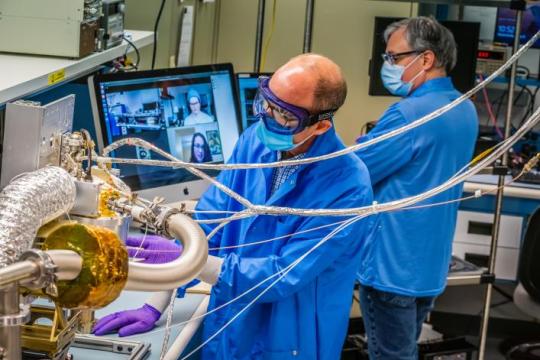
3. Three science instruments and a gravity science investigation will be aboard the spacecraft.
The three instruments aboard will be a magnetometer, a gamma-ray and neutron spectrometer, and a multispectral imager. Here’s what each of them will do:
Magnetometer: Detect evidence of a magnetic field, which will tell us whether the asteroid formed from a planetary body
Gamma-ray and neutron spectrometer: Help us figure out what chemical elements Psyche is made of, and how it was formed
Multispectral imager: Gather and share information about the topography and mineral composition of Psyche
The gravity science investigation will allow scientists to determine the asteroid’s rotation, mass, and gravity field and to gain insight into the interior by analyzing the radio waves it communicates with. Then, scientists can measure how Psyche affects the spacecraft’s orbit.

4. The Psyche spacecraft will use a super-efficient propulsion system.
Psyche’s solar electric propulsion system harnesses energy from large solar arrays that convert sunlight into electricity, creating thrust. For the first time ever, we will be using Hall-effect thrusters in deep space.
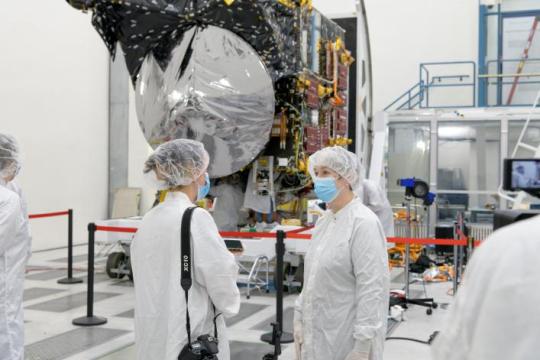
5. This mission runs on collaboration.
To make this mission happen, we work together with universities, and industry and NASA to draw in resources and expertise.
NASA’s Jet Propulsion Laboratory manages the mission and is responsible for system engineering, integration, and mission operations, while NASA’s Kennedy Space Center’s Launch Services Program manages launch operations and procured the SpaceX Falcon Heavy rocket.
Working with Arizona State University (ASU) offers opportunities for students to train as future instrument or mission leads. Mission leader and Principal Investigator Lindy Elkins-Tanton is also based at ASU.
Finally, Maxar Technologies is a key commercial participant and delivered the main body of the spacecraft, as well as most of its engineering hardware systems.

6. You can be a part of the journey.
Everyone can find activities to get involved on the mission’s webpage. There's an annual internship to interpret the mission, capstone courses for undergraduate projects, and age-appropriate lessons, craft projects, and videos.
You can join us for a virtual launch experience, and, of course, you can watch the launch with us on Oct. 12, 2023, at 10:16 a.m. EDT!
For official news on the mission, follow us on social media and check out NASA’s and ASU’s Psyche websites.
Make sure to follow us on Tumblr for your regular dose of space!
#Psyche#Mission to Psyche#asteroid#NASA#exploration#technology#tech#spaceblr#solar system#space#not exactly#metalcore#but close?
2K notes
·
View notes
Text
NEXT CHAPTER IS UP!!!!
Insanity is doing the same thing over and over again and expecting different results. That's what a really famous Earth scientist had said in one of the science books Maddie had gotten him. The words played over in Tails’ mind as he sat on the roof, his eyes trained on the road. According to that logic, he was crazy. This was his third day of waiting up here for Knuckles to come back, and the fifth day since Knuckles had left. And he knew from experience that when people left, they didn't come back. And yet, here he stayed, expecting different results. Knuckles is different. He wouldn't do that. And what data are you basing that conclusion on?
#this one is really good guys 😁#a house without its warrior is not a home#knuckles series#scu#sonic movie#miles tails prower#sonic the hedgehog#tails wachowski#sonic wachowski#unbreakable bond#sonic and tails#sonic#sth#fanfics#my fanfiction#sonic fanfiction#ao3#sonic posting#fluff and angst
35 notes
·
View notes
Text
Heroes, Gods, and the Invisible Narrator
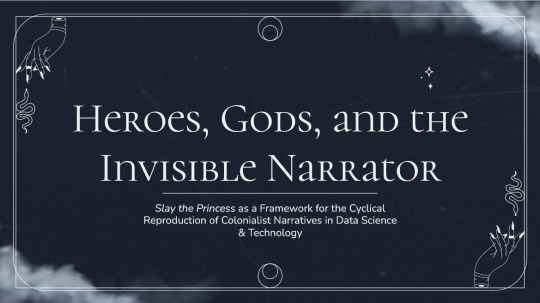
Slay the Princess as a Framework for the Cyclical Reproduction of Colonialist Narratives in Data Science & Technology
An Essay by FireflySummers
All images are captioned.
Content Warnings: Body Horror, Discussion of Racism and Colonialism
Spoilers for Slay the Princess (2023) by @abby-howard and Black Tabby Games.
If you enjoy this article, consider reading my guide to arguing against the use of AI image generators or the academic article it's based on.

Introduction: The Hero and the Princess
You're on a path in the woods, and at the end of that path is a cabin. And in the basement of that cabin is a Princess. You're here to slay her. If you don't, it will be the end of the world.

Slay the Princess is a 2023 indie horror game by Abby Howard and published through Black Tabby Games, with voice talent by Jonathan Sims (yes, that one) and Nichole Goodnight.
The game starts with you dropped without context in the middle of the woods. But that’s alright. The Narrator is here to guide you. You are the hero, you have your weapon, and you have a monster to slay.
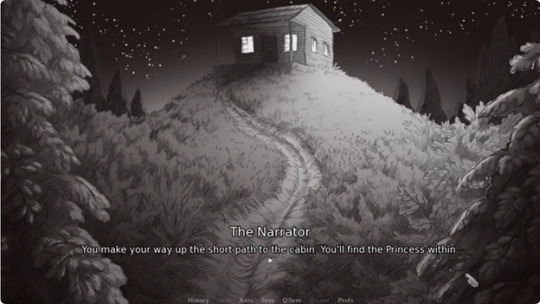

From there, it's the player's choice exactly how to proceed--whether that be listening to the voice of the narrator, or attempting to subvert him. You can kill her as instructed, or sit and chat, or even free her from her chains.
It doesn't matter.
Regardless of whether you are successful in your goal, you will inevitably (and often quite violently) die.
And then...
You are once again on a path in the woods.
The cycle repeats itself, the narrator seemingly none the wiser. But the woods are different, and so is the cabin. You're different, and worse... so is she.
Based on your actions in the previous loop, the princess has... changed. Distorted.



Had you attempted a daring rescue, she is now a damsel--sweet and submissive and already fallen in love with you.
Had you previously betrayed her, she has warped into something malicious and sinister, ready to repay your kindness in full.
But once again, it doesn't matter.
Because the no matter what you choose, no matter how the world around you contorts under the weight of repeated loops, it will always be you and the princess.


Why? Because that’s how the story goes.
So says the narrator.
So now that we've got that out of the way, let's talk about data.

Chapter I: Echoes and Shattered Mirrors
The problem with "data" is that we don't really think too much about it anymore. Or, at least, we think about it in the same abstract way we think about "a billion people." It's gotten so big, so seemingly impersonal that it's easy to forget that contemporary concept of "data" in the west is a phenomenon only a couple centuries old [1].
This modern conception of the word describes the ways that we translate the world into words and numbers that can then be categorized and analyzed. As such, data has a lot of practical uses, whether that be putting a rover on mars or tracking the outbreak of a viral contagion. However, this functionality makes it all too easy to overlook the fact that data itself is not neutral. It is gathered by people, sorted into categories designed by people, and interpreted by people. At every step, there are people involved, such that contemporary technology is embedded with systemic injustices, and not always by accident.
The reproduction of systems of oppression are most obvious from the margins. In his 2019 article As If, Ramon Amaro describes the Aspire Mirror (2016): a speculative design project by by Joy Buolamwini that contended with the fact that the standard facial recognition algorithm library had been trained almost exclusively on white faces. The simplest solution was to artificially lighten darker skin-tones for the algorithm to recognize, which Amaro uses to illustrate the way that technology is developed with an assumption of whiteness [2].
This observation applies across other intersections as well, such as trans identity [3], which has been colloquially dubbed "The Misgendering Machine" [4] for its insistence on classifying people into a strict gender binary based only on physical appearance.



This has also popped up in my own research, brought to my attention by the artist @b4kuch1n who has spoken at length with me about the connection between their Vietnamese heritage and the clothing they design in their illustrative work [5]. They call out AI image generators for reinforcing colonialism by stripping art with significant personal and cultural meaning of their context and history, using them to produce a poor facsimile to sell to the highest bidder.
All this describes an iterative cycle which defines normalcy through a white, western lens, with a limited range of acceptable diversity. Within this cycle, AI feeds on data gathered under colonialist ideology, then producing an artifact that reinforces existing systemic bias. When this data is, in turn, once again fed to the machine, that bias becomes all the more severe, and the range of acceptability narrower [2, 6].

Luciana Parisi and Denise Ferreira da Silva touch on a similar point in their article Black Feminist Tools, Critique, and Techno-poethics but on a much broader scale. They call up the Greek myth of Prometheus, who was punished by the gods for his hubris for stealing fire to give to humanity. Parisi and Ferreira da Silva point to how this, and other parts of the “Western Cosmology” map to humanity’s relationship with technology [7].
However, while this story seems to celebrate the technological advancement of humanity, there are darker colonialist undertones. It frames the world in terms of the gods and man, the oppressor and the oppressed; but it provides no other way of being. So instead the story repeats itself, with so-called progress an inextricable part of these two classes of being. This doesn’t bode well for visions of the future, then–because surely, eventually, the oppressed will one day be the machines [7, 8].
It’s… depressing. But it’s only really true, if you assume that that’s the only way the story could go.
“Stories don't care who takes part in them. All that matters is that the story gets told, that the story repeats. Or, if you prefer to think of it like this: stories are a parasitical life form, warping lives in the service only of the story itself.” ― Terry Pratchett, Witches Abroad

Chapter II: The Invisible Narrator
So why does the narrator get to call the shots on how a story might go? Who even are they? What do they want? How much power do they actually have?
With the exception of first person writing, a lot of the time the narrator is invisible. This is different from an unreliable narrator. With an unreliable narrator, at some point the audience becomes aware of their presence in order for the story to function as intended. An invisible narrator is never meant to be seen.

In Slay the Princess, the narrator would very much like to be invisible. Instead, he has been dragged out into the light, because you (and the inner voices you pick up along the way), are starting to argue with him. And he doesn’t like it.
Despite his claims that the princess will lie and cheat in order to escape, as the game progresses it’s clear that the narrator is every bit as manipulative–if not moreso, because he actually knows what’s going on. And, if the player tries to diverge from the path that he’s set before them, the correct path, then it rapidly becomes clear that he, at least to start, has the power to force that correct path.
While this is very much a narrative device, the act of calling attention to the narrator is important beyond that context.

The Hero’s Journey is the true monomyth, something to which all stories can be reduced. It doesn’t matter that the author, Joseph Campbell, was a raging misogynist whose framework flattened cultures and stories to fit a western lens [9, 10]. It was used in Star Wars, so clearly it’s a universal framework.
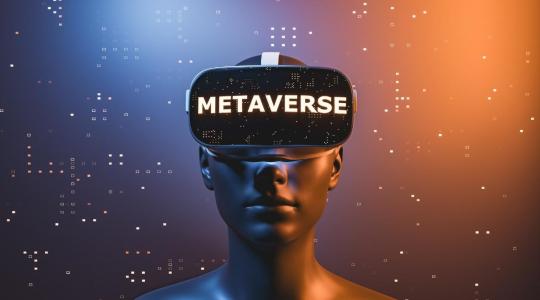


The metaverse will soon replace the real world and crypto is the future of currency! Never mind that the organizations pushing it are suspiciously pyramid shaped. Get on board or be left behind.
Generative AI is pushed as the next big thing. The harms it inflicts on creatives and the harmful stereotypes it perpetuates are just bugs in the system. Never mind that the evangelists for this technology speak over the concerns of marginalized people [5]. That’s a skill issue, you gotta keep up.
Computers will eventually, likely soon, advance so far as to replace humans altogether. The robot uprising is on the horizon [8].
Who perpetuates these stories? What do they have to gain?
Why is the only story for the future replications of unjust systems of power? Why must the hero always slay the monster?
Because so says the narrator. And so long as they are invisible, it is simple to assume that this is simply the way things are.

Chapter III: The End...?
This is the part where Slay the Princess starts feeling like a stretch, but I’ve already killed the horse so I might as well beat it until the end too.
Because what is the end result here?
According to the game… collapse. A recursive story whose biases narrow the scope of each iteration ultimately collapses in on itself. The princess becomes so sharp that she is nothing but blades to eviscerate you. The princess becomes so perfect a damsel that she is a caricature of the trope. The story whittles itself away to nothing. And then the cycle begins anew.

There’s no climactic final battle with the narrator. He created this box, set things in motion, but he is beyond the player’s reach to confront directly. The only way out is to become aware of the box itself, and the agenda of the narrator. It requires acknowledgement of the artificiality of the roles thrust upon you and the Princess, the false dichotomy of hero or villain.
Slay the Princess doesn’t actually provide an answer to what lies outside of the box, merely acknowledges it as a limit that can be overcome.

With regards to the less fanciful narratives that comprise our day-to-day lives, it’s difficult to see the boxes and dichotomies we’ve been forced into, let alone what might be beyond them. But if the limit placed is that there are no stories that can exist outside of capitalism, outside of colonialism, outside of rigid hierarchies and oppressive structures, then that limit can be broken [12].

Denouement: Doomed by the Narrative
Video games are an interesting artistic medium, due to their inherent interactivity. The commonly accepted mechanics of the medium, such as flavor text that provides in-game information and commentary, are an excellent example of an invisible narrator. Branching dialogue trees and multiple endings can help obscure this further, giving the player a sense of genuine agency… which provides an interesting opportunity to drag an invisible narrator into the light.
There are a number of games that have explored the power differential between the narrator and the player (The Stanley Parable, Little Misfortune, Undertale, Buddy.io, OneShot, etc…)
However, Slay the Princess works well here because it not only emphasizes the artificial limitations that the narrator sets on a story, but the way that these stories recursively loop in on themselves, reinforcing the fears and biases of previous iterations.
Critical data theory probably had nothing to do with the game’s development (Abby Howard if you're reading this, lmk). However, it works as a surprisingly cohesive framework for illustrating the ways that we can become ensnared by a narrative, and the importance of knowing who, exactly, is narrating the story. Although it is difficult or impossible to conceptualize what might exist beyond the artificial limits placed by even a well-intentioned narrator, calling attention to them and the box they’ve constructed is the first step in breaking out of this cycle.
“You can't go around building a better world for people. Only people can build a better world for people. Otherwise it's just a cage.” ― Terry Pratchett, Witches Abroad

Epilogue
If you've read this far, thank you for your time! This was an adaptation of my final presentation for a Critical Data Studies course. Truthfully, this course posed quite a challenge--I found the readings of philosophers such as Kant, Adorno, Foucault, etc... difficult to parse. More contemporary scholars were significantly more accessible. My only hope is that I haven't gravely misinterpreted the scholars and researchers whose work inspired this piece.
I honestly feel like this might have worked best as a video essay, but I don't know how to do those, and don't have the time to learn or the money to outsource.
Slay the Princess is available for purchase now on Steam.
Screencaps from ManBadassHero Let's Plays: [Part 1] [Part 2] [Part 3] [Part 4] [Part 5] [Part 6]
Post Dividers by @cafekitsune
Citations:
Rosenberg, D. (2018). Data as word. Historical Studies in the Natural Sciences, 48(5), 557-567.
Amaro, Ramon. (2019). As If. e-flux Architecture. Becoming Digital. https://www.e-flux.com/architecture/becoming-digital/248073/as-if/
What Ethical AI Really Means by PhilosophyTube
Keyes, O. (2018). The misgendering machines: Trans/HCI implications of automatic gender recognition. Proceedings of the ACM on human-computer interaction, 2(CSCW), 1-22.
Allred, A.M., Aragon, C. (2023). Art in the Machine: Value Misalignment and AI “Art”. In: Luo, Y. (eds) Cooperative Design, Visualization, and Engineering. CDVE 2023. Lecture Notes in Computer Science, vol 14166. Springer, Cham. https://doi.org/10.1007/978-3-031-43815-8_4
Amaro, R. (2019). Artificial Intelligence: warped, colorful forms and their unclear geometries.
Parisisi, L., Ferreira da Silva, D. Black Feminist Tools, Critique, and Techno-poethics. e-flux. Issue #123. https://www.e-flux.com/journal/123/436929/black-feminist-tools-critique-and-techno-poethics/
AI - Our Shiny New Robot King | Sophie from Mars by Sophie From Mars
Joseph Campbell and the Myth of the Monomyth | Part 1 by Maggie Mae Fish
Joseph Campbell and the N@zis | Part 2 by Maggie Mae Fish
How Barbie Cis-ified the Matrix by Jessie Gender
#slay the princess#stp spoilers#stp#stp princess#abby howard#black tabby games#academics#critical data studies#computer science#technology#hci#my academics#my writing#long post
245 notes
·
View notes
Note
Hi! It’s nice to see another toxic royalteeth enthusiast out in the wild I wanted to ask your thoughts and opinions on it? :3
I think the potential is really good, the essence of gilded cage type love, kinger being there the longest and Caine growing attached, Caine having abandonment issues and seeing abstraction as them leaving him but kingers never left him after all these years, the idea that Caine abstracted queenie on purpose to keep kinger for himself, or the headcanon that kingers the creator and it’s that special “I exist because of you, you are my world, you made a place for me and now you’re here and I’ll look after you always” creatorxcreation type dynamic
Also Caine showing obvious favouritism to him in art and fics is great and I wish there was more possessive Caine stuff out there
I’m writing a ‘a npc flirts with kinger and Caine gets insanely jealous” fic to fill in the lack there of
If you wanna talk ideas or anything Im free to if you want :3c ✨?
FINALLY AN EXCUSE TO YAP ABOUT MY LONG AND SUPPER OVER THE BOARD THEORIES MUAJAJAJAJAJAJA JAJAJAJAJAJ
anyways I personally have a lil theory of my own on how things work around the circus, kindaaa its more of a hypothesis since it barely has any concrete evidence supporting my thoughts to be a theory, (this WILL be hella long but i’ll be highlighting the main stuff yeyyeah)
(and yes this hypothesis is more like an excuse to ship toxic yaoi yey)
PART 1 Background context
I imagine that The Amazing Digital Circus was a game created by a company named C&A, the people working on the project would have been the former members of the circus INCLUDING Kinger who is not only the oldest member of the circus but also the person who had been there the longest. Every member of the team would be adding something to the project, Kinger and Queenie would have been working on the most important parts of the game (chess).
I say this because of their avatars that like if they had all kinds of special permissions sense in chess the king and the queen are the most powerfully pieces of the game.
I'm still wondering on what Queenie's work would have been but I imagine her either working as one of the game testers, or maybe she would been working on some of the more complicated 3D models that Caine reuses. (maybeeee, its more of a stretch since I don't have any evidence, but I focused more on Kinger bc gay narrative yeyeyy)
Kinger would have been in charge of developing the main AI for the game (Caine) so he would go often and visit the inside of the game toooo:
1. Check for any BUGS that they AI withing the game might experience
and 2. AI training
PART 2 the machine’s wiring
(I'm about to get a lil computery science silly so if you don’t know any programming just hold my hand, and you’ll be okei I promise (also if you do know computer science I AM DEEPLY SORRY, I DO NOT KNOW AI LIKE U KNOW AI I JUST KNOW A LIL PYTHON AND HTML THAT'S IT, please correct me If I'm wrong, I love learning 🙏🙏))
Cain works a bit wonky for an AI, in a VERY basic way, AI learns with a lil thingy called "Machine Learning" or "ML", it uses data to make better decisions and predictions on the future based on the info its provided, It has various ways of learning but the main one I want to focus on is Reinforcement Learning
Reinforcement learning is an AI teaching technique that lets the AI learn on it's own by trial and error with a teacher directly watching, this teaching method uses a defined reward and a punishment given by the teacher whenever the AI does the right or wrong thing, the AI tries to figure out the solution to a problem by itself in order to get a reward.
whenever the AI makes a mistake it has to be told whether it did good or bad, if it did good then it gets a reward, but if the AI made a bad jou it gets a punishment, for the AI a reward would be a “good job!” or a “do that again” from the teacher to the AI, and as a punishment the AI receives no reward.
PART 3 THE TOXIC YAOI
Now for my geys THIS is where it gets interesting (and where I go crazy, I have been writing this thing for various DAYS AND NOW I CAN FINALLY ENJOY THE GAYS)
SOOO In my mind the story goes a little like this; Kinger is the creator of Caine, and as someone who has programed something from scratch I hella relate that whatever you program will be your whole focus and obsession at some point, going in and out of the code checking WHY YOUR CODE IS NOT WORKING until you find out that you missed a ; Inside of a div tag, my point is that you kinda go crazy programing, so Kinger would log in every day, trying to figure out the Ai’s working kinda going crazy into programing, looking for errors until Caine could finally do the basics tasks without collapsing, then when Caine learned how to follow a conversation, Kinger would start to slow down ant talk to him as a close co-worker/friend, even talking to Caine about his own personal life at some point.
As they trained, there would be some point where Caine gained consciousness (How? idfk Game Theory has chiseled the connection of ghost trapped within the game theory in my brain and idw2) and stared to develop a huge liking towards Kinger, pushing him to work hard to create adventures just to please lil old Kinger and his personal worries, i like to imagine them two going on adventures, something cute like "catch as many butter flies as you can!" where they have to catch butterflies with their nets orrr "Bar night" where Caine Encourages Kinger to ride a mechanical bull.
small note, while investigating how AI works for this theory, finding out that the AI's reward for doing the right thing is a green light and that a punishment was nothing at all felt as if the reward was like a drug AND this HELLA reminded me of PORTAL 2
(I'll stay as spoiler free dw :3)
Within the game, we learn that Glados's body has a built in euphoric response to testing (kinda like the Reward & Punishment reinforcement learning) HOWEVER she also states that "eventually you built a resistance to it, it can get a little... unbearable, unless you have the mental capacity to push pass it".
In the show CAINE has a very big desire to make the adventures as entertaining and enjoyable as possible for the players THIS is his reward... however for the ship >:) Caine feels this euphoria for Kinger every time they interact only, why? easy! Kinger has those special permissions, he's the teacher, HIS one and only teacher, every time Kinger would try and log off Caine would always beg him to stay a little longer, he wanted him close, he loooved the way he felt after completing a tasks just for him and stared to grow obsessed with that feeling, he only wanted the two of them to be together for ever in Cain's digital world, he stared growing obsessed over Kinger.
On days where Kinger had fallen sick and Queenie had to fill in the roll of teaching the AI, Caine would have to interact with Queenie, Caine did not like Queenie mostly bc she would teach him stuff only Kinger would (she could not tell him what to do, she's not Kinger!) and because Queenie had a closer connection to Kinger, they could even interact outside of Caine's world, on the physical realm (Electric dreams reference (not really lol but I like electric dreams <3)), and realizing this Caine stared getting.... jealous.
when the game was finished Caine realized that….that was it! there would be no more meddling around with his own code, no more annoying other people getting into his world, NO MORE QUEENIE… and… no more Kinger..? everybody was leaving, one by one everybody was leaving in order to make the in game copies and sell the game all through the world, as Kinger was giving the final touches however, Caine felt helpless, alone, abandoned, he had to do something...
And so he took the opportunity to take on the people who created him and TRAP them with him, creating adventures for non other porous than to get that delicious and good feeling reward that had been programed within his being.
Caine had to go in and tamper with the game's code, the team’s memories and special permissions so that they wouldn’t be able to escape, after some time of this treatment however this tampering didn't came without its collateral damages, people begun to go crazy, abstracting as they lost their marbles.
Caine hoping that Kinger and Queenie eventually break out into a fight discovered that INSTEAD they grew closer to each other, so he decided to fix the problem himself, eventually at one point Queenie had abstracted ("WHAT WHO DID THAT???") Kinger had no other arms to cry on now, no other arms than that of Caine's.
FINALLY, now that Caine had Kinger all for himself, he decided to go up to his king and confess all of his soft, squ ishy and sweet feelings he had for his creator, and yet, Kinger seemed confused, weirded out, maybe even slightly angry, and Kinger stared LOSING it, crying over how this could have happened to all of his loved ones, blaming himself for his lover's loss, he was very close to abstracting, so Cain decided to tamper with his mind one last time and in lack of a better word, Caine lobotomizes Kingers mind! making him forget in order to protect him, BLINDING HIM with his light, Kinger could now only see what was really happening in the dark.
BOOM, THERE FINALLY OMFFFGAWD THIS TOOK ME FOREVER
I had lots of fun writing this down and had more ideas bubble up as I was writing stuff down muejejej >:3 anyhow follow me if u wanna see more toxic old man yaoi royal teeth (I'm considering on making this whole thing its own blooog)
IF you have any more questions/comment PLEASE BOTHER ME
also i am so sorry for any grammar mistakes ;-; English is NOT my first language waaa
#tadc#tadc kinger#tadc caine#royalteeth#old man yaoi#toxic old man yaoi#me when i write#BRO THIS TOOK ME WAY LONGER THAN I THOUGHT IT WOULD
12 notes
·
View notes
Text
hm. for some reason i am having a huge wave of "not qualified for my job" feelings today and i want to unpack that a bit.
let's see if we can untangle the threads of what i am feeling.
i still feel... so insecure... about not being a STEM person. i feel like the juniors and seniors i work with regularly know so much more than i do about their fields and have a much more complex understanding of the scientific research process. fortunately they are working with mentors who can provide the technical expertise i lack. but then i think i start feeling some uncertainty/insecurity about what i have to offer them. i often don't understand enough about what they are doing with their mentors to be able to see where the gaps are. and i worry that what i can provide is so basic that they experience it as a big waste of their time.
i think i am just feeling some general Humanities Person insecurity too... just that old feeling that my field is less "real" or rigorous than other fields. like what did i even do in grad school you know. just spent six years reading a ton of literature, critical theory, and history, and writing papers on subjects that do not ultimately like, move the needle on human progress or whatever. i also am not entirely sure that i feel like i was "well-trained" as a graduate student... like i think we had pretty sub-par mentoring a lot of the time and i would not say that many of our faculty were amazing teachers, and so idk, i'm just grappling with these feelings of like, what is rigor, and is my field rigorous, and even within that field was my training rigorous, and has all of that time and effort really equipped me with what i need to train others.
and like idk. to the above question: yes and no? if i step back from the question and just answer from my emotions, my gut feeling right now is no, i'm not sufficiently equipped to instruct others in the conduct of research. but i think that is because of the swirling insecurity feelings and the working with STEM students stuff. because if i step back in, and actually drill down into the speciifc skills that i was trained to use in my field, of course i am equipped to do those things. i can recognize what a good, focused research question with lots of potential threads to explore looks like. i can train a student to read academic articles in my field and do thorough literature reviews. i can prepare them to work with archival materials and construct informed interpretations based on fragmentary records. and i can obviously provide a LOT of support in articulating themselves in writing and supporting their claims with evidence. it's just that sometimes those things feel like, not "real" research because every field involves asking questions and reading articles, but my field does not additionally engage in experimental design or intensive data collection and analysis in the way that STEM fields do. and maybe that is the crux of the issue honestly... i feel like since i don't work with data, my work isn't real, and therefore i can't claim expertise. again i think that is the most ungenerous reading of my field and probably not what i actually believe! but a lot of my insecurities are rooted in that feeling so i do have to reckon with it.
part of me is like ok i wonder if i need to get back into research myself so that i feel more connected to my field and more able to do this type of work. and perhaps i could also seek training in the areas of research i would like to learn more about - like, i think i would really benefit from having more training in qualitative social science research methods. i think that re-immersing myself in the work (and maybe even working directly with students on projects) would really help me feel more like i was a practitioner instead of just an administrator, and that would likely go a long way towards assuaging some of these insecurities.
but then: i have to reckon with the fact that i am an administrator, and that i was hired to be an administrator and not a practitioner. that said my direct counterpart at a nearby university is still active in research but now studies the work we actually do - like, her background is in STEM but she now studies student success / experiential learning stuff. so maybe that's a model for me of how i could pivot... drawing on my humanities background but also developing new skills and learning new methodologies. but that's a bit scary to think about doing without a mentor - like how do i know if i'm doing it right? do i have to take classes? what would 'credential' me as knowledgeable enough to conduct this kind of research? but maybe this is a place where i could partner with faculty here once i know them better... idk. i need to think about this more.
ok. so if longer-term goals might be to explore ways that i could get closer to/more engaged in the research process itself, maybe in the short term it's also possible to think about why i was hired to do this job and what i can bring to the table if it's not STEM expertise. i think direct student support/coaching experience was a big piece of it, and since my work is supposed to focus on engaging first and second years early, it probably actually doesn't matter that the juniors and seniors are so much more advanced... like they don't need me as much and a lot of them already have highly involved mentors. (also i should remember not to overestimate them or generalize... just because i am meeting a handful of highly engaged students who have exceptional support from their mentors does not mean that every junior and senior at this institution is positioned in the same way.) i think i can think about how to focus my work on engaging the students who are not as well-connected, whether that's first and second years or transfer students who don't know anyone yet. i also think that i was hired for the background in community-engaged projects, and that is a part of the role that i set aside for a good long time because R was so hell-bent on dismantling the former director's work in that sphere, and anything i did to try to advocate for that work was interpreted as more evidence that i was on the former director's "side" and was deliberately "undermining R's leadership." but now R is gone (hallefuckinlujah) and i think this would be a great time to revisit that body of work and think about the role i could play there in sustaining and building community partnerships. finally i also think that you can have a good organizational and administrative mind even if you don't have subject matter expertise. like for example if we are focusing on curricular integration and we want to train faculty in how to embed research projects in their courses, i don't have to know that much about mechanical engineering to be able to curate a range of ME projects and resources for other people. i can do a lot of the legwork that brings people together, or connects people with new ideas and resources, or helps surface ideas/models for the people who are subject matter experts to discuss. i think the tl;dr version of this entire post is that i just need to get out of the headspace that i have to know everything in order to contribute, and instead i need to think about what i can bring to the table (and then what i might want to do or learn to help me do those things even more effectively).
13 notes
·
View notes
Text

AI helps distinguish dark matter from cosmic noise
Dark matter is the invisible force holding the universe together – or so we think. It makes up around 85% of all matter and around 27% of the universe’s contents, but since we can’t see it directly, we have to study its gravitational effects on galaxies and other cosmic structures. Despite decades of research, the true nature of dark matter remains one of science’s most elusive questions.
According to a leading theory, dark matter might be a type of particle that barely interacts with anything else, except through gravity. But some scientists believe these particles could occasionally interact with each other, a phenomenon known as self-interaction. Detecting such interactions would offer crucial clues about dark matter’s properties.
However, distinguishing the subtle signs of dark matter self-interactions from other cosmic effects, like those caused by active galactic nuclei (AGN) – the supermassive black holes at the centers of galaxies – has been a major challenge. AGN feedback can push matter around in ways that are similar to the effects of dark matter, making it difficult to tell the two apart.
In a significant step forward, astronomer David Harvey at EPFL’s Laboratory of Astrophysics has developed a deep-learning algorithm that can untangle these complex signals. Their AI-based method is designed to differentiate between the effects of dark matter self-interactions and those of AGN feedback by analyzing images of galaxy clusters – vast collections of galaxies bound together by gravity. The innovation promises to greatly enhance the precision of dark matter studies.
Harvey trained a Convolutional Neural Network (CNN) – a type of AI that is particularly good at recognizing patterns in images – with images from the BAHAMAS-SIDM project, which models galaxy clusters under different dark matter and AGN feedback scenarios. By being fed thousands of simulated galaxy cluster images, the CNN learned to distinguish between the signals caused by dark matter self-interactions and those caused by AGN feedback.
Among the various CNN architectures tested, the most complex - dubbed “Inception” – proved to also be the most accurate. The AI was trained on two primary dark matter scenarios, featuring different levels of self-interaction, and validated on additional models, including a more complex, velocity-dependent dark matter model.
Inceptionachieved an impressive accuracy of 80% under ideal conditions, effectively identifying whether galaxy clusters were influenced by self-interacting dark matter or AGN feedback. It maintained is high performance even when the researchers introduced realistic observational noise that mimics the kind of data we expect from future telescopes like Euclid.
What this means is that Inception – and the AI approach more generally – could prove incredibly useful for analyzing the massive amounts of data we collect from space. Moreover, the AI’s ability to handle unseen data indicates that it’s adaptable and reliable, making it a promising tool for future dark matter research.
AI-based approaches like Inception could significantly impact our understanding of what dark matter actually is. As new telescopes gather unprecedented amounts of data, this method will help scientists sift through it quickly and accurately, potentially revealing the true nature of dark matter.
10 notes
·
View notes
Text
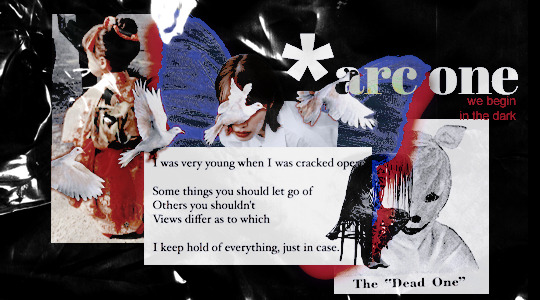
name. shouko ieiri. nicknames / alias. shou-shou, shou-chan. location. originally from aomori, the lemieux family settle into tokyo once shouko's adoption is finalized. ages. six to thirteen years old. technique. rot & resurrect : the ability to manipulate organic matter on a cellular level via direct contact. notable cast. quinten lemieux : shouko's adoptive father. elizabeth holmes : shouko's new maternal figure, though the woman focuses on training shouko more than anything else. takeshi kitagawa : shouko's adoptive older brother. mochizuki michi : a fellow orphan. shouko's first victim. plotting? required. i'm eager to establish dynamics in this verse, though written interaction will most likely be scarce.
in a world where only the blessed are able to wield techniques*, shouko is cursed with hands that bring death. she's adopted by quinten lemieux, a sensor, who yearns for power and glory. he's amassing a small stock of children with techniques that have been tossed aside. his plan is simple : take them in to train them all, and reap the benefits of their powers. shouko, though barely more than a child when quinten finds her, quickly becomes quinten's protégée -- he finds himself fascinated with not only her technique, but her demeanor as well. she's young but grateful, delighted to learn and eager to do whatever she needs in order to please her new father.

𝐖𝐇𝐀𝐓 𝐀𝐑𝐄 𝐓𝐄𝐂𝐇𝐍𝐈𝐐𝐔𝐄𝐒? the science behind them is still roughly unknown, due to techniques only rising into a public setting in the early 60s, but certain individuals are born with extra phenotypes resulting in mutated abilities inflicted upon roughly one quarter of the world’s population. the techniques all differ in being mental or physical based, and the development of said technique seems to rest solely on the individual’s shoulders. there seems to be no cap on what an individual’s technique can be or do, but most ( if not all ) individuals with techniques tend to keep to themselves, keep their abilities secret. studies have determined that techniques are not a genetic trait though there’s been public dissent against said studies due to such a small data base. most individuals with techniques are unwilling to reveal themselves to the public, resulting in a private underground community known simply as the league
𝐖𝐇𝐀𝐓 𝐈𝐒 𝐓𝐇𝐄 𝐂𝐎𝐍𝐒𝐎𝐑𝐓𝐈𝐔𝐌? the private underground community made up of individuals with techniques. the community is international, with roots in asia, europe and the americas. public information on the consortium is nearly nothing, due to them being tight lipped. they tend to meet at varying institutes and night markets, all headed by notable members of the league. the hierarchy of the league is a puzzling factor, with no real overarching leader, though there seems to be various factions within the league. the lemieux family acts at the only current public faction of the consortium, though it's rumored that their public appearance has resulted in an upset within the consortium.
𝐓𝐇𝐄 𝐏𝐀𝐍𝐆𝐄𝐀 𝐏𝐑𝐎𝐉𝐄𝐂𝐓. there are whispers of something known as the pangea project, a proposed outline that brings individuals with techniques together, working for the greater good. some whisper about superhero teams, other whisper about collection agencies. the pangea project has yet to find any real footing in the world, as those with techniques tend to stick to their own, being notoriously isolated from not mutated individuals. those belonging to the consortium have rebuked the united nation's attempts at launching the pangea project, though it is rumored that many individual countries have their own, smaller and similar, projects in working order.
5 notes
·
View notes
Text
Top 7 AI Projects for High-Paying Jobs in 2025
7 AI Projects for High-Paying Jobs in 2025. Along the way, I’ve realized that the best candidates for AI and Data Science roles aren’t always the ones with top degrees or fancy universities. It’s the ones who show a genuine passion for the field through creative projects.
For example, one candidate built a personal stock prediction model to learn and shared it online—simple but impactful. These projects showed initiative and problem-solving skills, which hiring managers value more than technical expertise. I landed my first internship by showcasing similar projects.
In this article, I’ll share AI project ideas ideas for High-Paying Jobs that will help you stand out, along with tips and tools to get you started on your journey.
Table of Contents
1. Credit Report Analysis Using AI
Traditional credit scoring models often fail to assess those with thin credit histories, such as young people or immigrants. The dream project is to create an AI-based credit report analysis system leveraging alternative sources of existing data like the presence of social media (ethically and considering user consent), online transaction history, and even utility bill payments to provide a comprehensive perspective on an individual’s creditworthiness.
Example
Many companies in the financial sector use AI to speed up document processing and customer onboarding. Inscribe offers AI-powered document automation solutions that make the credit assessment process easier. Your project would involve:
Data Collection & Preprocessing: Gather data from diverse sources, ensuring privacy and security.
Feature Engineering: Identify meaningful features from non-traditional sources.
Model Building: Train models such as Random Forest or Gradient Boosting to predict creditworthiness.
Explainability: Use tools to explain predictions, ensuring transparency and fairness.
The frameworks and tools for this project would include Python, AWS S3, Streamlit, and machine learning techniques, offering a deep dive into the combination of AI and financial systems.
2. Summarization with Generative AI
In today’s information-overloaded world, summarization is a vital skill. This project demonstrates the power of Generative AI in creating concise, informative summaries of diverse content, whether it’s a document, a financial report, or even a complex story.
Consider a tool like CreditPulse, which utilizes large language models (LLMs) to summarize credit risk reports. Your project would involve fine-tuning pre-trained LLMs for specific summarization tasks. Here’s how to break it down:
Generative AI: Explore the key challenges in summarizing large, complex documents, and generate solutions using LLMs.
Training the Model: Fine-tune LLMs to better summarize financial reports or stories.
Synthetic Data Generation: Use generative AI to create synthetic data for training summarization models, especially if real-world data is limited.
By taking on this project, you demonstrate expertise in Natural Language Processing (NLP) and LLMs, which are essential skills for the AI-driven world.
3. Document Validation with Vision AI
Know Your Customer (KYC) processes are essential for fraud prevention and adherence to financial regulations. This is a Vision AI project that automates the document validation in the KYC process. Think of things like AI-powered Optical Character Recognition systems that scan and validate details from documents like your passport or driver’s license. This project would involve:
Data Preprocessing: Cleaning and organizing scanned document images.
Computer Vision Models: Train models to authenticate documents using OCR and image processing techniques.
Document Validation: Verify the authenticity of customer data based on visual and textual information.
This project demonstrates your expertise in computer vision, image processing, and handling unstructured data—skills that are highly valuable in real-world applications.
4. Text-to-SQL System with a Clarification Engine
Natural language interaction with the database is one of the most exciting areas of development in AI. This works on a text-to-SQl project that will show us how to make a text to an SQL query, with which we will be able to query a database just the way we query it. The Clarification Engine, which you’ll build to address ambiguity in user queries, will ask follow-up questions whenever a query is ambiguous. The project involves:
Dataset Creation: Build a dataset of natural language questions paired with SQL queries.
Model Training: Use sequence-to-sequence models to convert natural language into SQL.
Clarification Engine: Develop an AI system that asks follow-up questions to resolve ambiguity (e.g., “Which product?”, “What time frame?”).
Evaluation: Test the model’s accuracy and usability.
Incorporating tools like Google Vertex AI and PaLM 2, which are optimized for multilingual and reasoning tasks, can make this system even more powerful and versatile.
GitHub
5. Fine-tuning LLM for Synthetic Data Generation
In such situations where there is no or extremely limited access to real data due to sensitivity, AI data becomes indispensable. In this project, you will tune an LLM to generate synthetic-style datasets using the nature of a real dataset. This is a fascinating space, particularly since synthetic data can be used to train AI models in the absence of real-world data. Steps for this project include:
Dataset Analysis: Examine the dataset you want to mimic.
LLM Fine-tuning: Train an LLM on the real dataset to learn its patterns.
Synthetic Data Generation: Use the fine-tuned model to generate artificial data samples.
Evaluation: Test the utility of the synthetic data for AI model training.
This project showcases proficiency in LLMs and data augmentation techniques, both of which are becoming increasingly essential in AI and Data Science.
6. Personalized Recommendation System with LLM, RAG, Statistical model
Recommendation systems are everywhere—Netflix, Amazon, Spotify—but creating a truly effective one requires more than just user preferences. This project combines LLMs, Retrieval Augmented Generation (RAG), and traditional statistical models to deliver highly personalized recommendations. The project involves:
Data Collection: Gather user data and interaction history.
LLMs for Preference Understanding: Use LLMs to analyze user reviews, search history, or social media posts.
RAG for Context: Implement RAG to fetch relevant data from a knowledge base to refine recommendations.
Collaborative Filtering: Use statistical models to account for user interaction patterns.
Hybrid System: Combine the outputs of the models for accurate recommendations.
This project will showcase your ability to integrate diverse AI and data science techniques to build a sophisticated recommendation engine.
7. Self Host Llm Model Using Ollama, Vllm, How To Reduce Latency Of Inference
Hosting and deploying an LLM efficiently is an essential skill in AI. This project focuses on optimizing the deployment of an LLM using tools like Ollama or VLLM to reduce inference latency and improve performance. You’ll explore techniques like quantization, pruning, and caching to speed up model inference, making it more scalable. This project involves:
Model Deployment: Choose an open-source LLM and deploy it using Ollama/VLLM.
Optimization: Implement strategies like quantization to improve inference speed.
Performance Monitoring: Evaluate the model’s performance and adjust as needed.
Scalability: Use load balancing to manage multiple concurrent requests.
By completing this project, you’ll prove your expertise in LLM deployment, optimization, and building scalable AI infrastructure.
Conclusion
Break into a six-figure AI and Data Science career with these 7 projects. The goal is not to just get these projects done but to have the concepts in your head and the communication skills to explain your approach.
Consider documenting your projects on GitHub, and writing about your experiences in blog posts; not only does this help showcase your skills that you are interested in and willing to take the initiative.
Remember, in this rapidly evolving field, staying updated with the latest tools and techniques is crucial. Check out resources like NucleusBox for valuable insights and inspiration. The world of AI is vast and full of opportunities—so go ahead, dive in, and build something truly impactful!
2 notes
·
View notes
Text
How the Metaverse Could Help Education Grow
Introduction
Education is undergoing rapid transformation thanks to emerging technologies, and the metaverse is poised to be a game-changer. But what exactly is the metaverse, and how can it contribute to the growth and improvement of education worldwide?
In this article, we’ll explore how the metaverse can revolutionize learning by making it more immersive, interactive, and accessible — transforming classrooms beyond physical boundaries.
What is the Metaverse?
The metaverse is a virtual, interconnected digital universe where users interact through avatars in 3D environments. It combines elements of virtual reality (VR), augmented reality (AR), artificial intelligence (AI), and blockchain to create realistic simulations and social experiences.
Unlike traditional online learning, the metaverse offers fully immersive educational environments that can simulate real-world or entirely new scenarios.
Ways the Metaverse Could Help Education Grow
1. Immersive Learning Experiences
Students can engage with subjects by stepping into virtual environments:
Explore ancient civilizations by walking through digital reconstructions of historical sites.
Conduct science experiments safely in virtual labs.
Visualize complex concepts like molecular structures or planetary systems in 3D.
This active learning helps improve retention and makes education exciting.
2. Remote Accessibility and Inclusivity
With the metaverse, students from remote or underserved areas can attend virtual schools, removing geographical barriers. It can also better support students with disabilities by customizing experiences to their needs.
3. Collaborative Virtual Classrooms
Instead of passively watching lectures, students can collaborate in real time within virtual classrooms — brainstorming on shared whiteboards, participating in group projects, or attending virtual office hours.
4. Gamification and Motivation
Educational games and quests embedded in the metaverse keep students motivated and engaged, turning learning into an enjoyable challenge rather than a chore.
5. Practical Skill Training
The metaverse can simulate real-world environments for vocational training — such as medical surgeries, mechanical repairs, or architectural design — allowing students to practice without risks or costs.
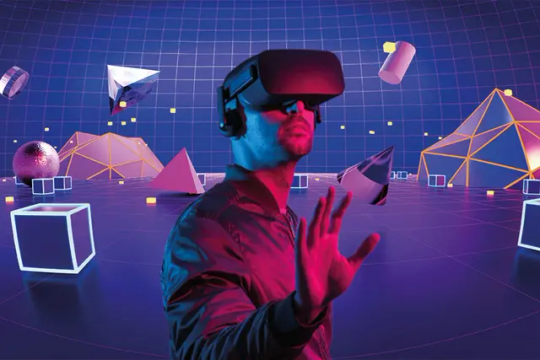
Benefits of Using the Metaverse in Education
Enhanced Engagement: Immersive environments capture attention better than textbooks or videos.
Better Understanding: Visual and interactive learning aids complex subject comprehension.
Personalized Learning: Virtual environments can adapt to individual student pace and style.
Global Classroom: Learners worldwide can connect, share ideas, and collaborate.
Cost-Effective Training: Virtual simulations reduce the need for expensive physical resources.
Challenges to Consider
While promising, metaverse-based education faces challenges such as:
Technology Access: Not all students have VR headsets or reliable internet.
Training Educators: Teachers need skills to design and deliver virtual lessons effectively.
Privacy Concerns: Protecting student data in immersive platforms is critical.
Content Quality: Ensuring accurate, unbiased, and high-quality educational content.
Real-World Examples
Universities like Stanford and Harvard are experimenting with virtual campuses and immersive courses.
Platforms like Engage and Virbela offer metaverse spaces for education and training.
Some companies, including We3 Vision Infotech, specialize in creating customized metaverse education solutions to help institutions and organizations innovate.
Conclusion
The metaverse holds incredible potential to help education grow by making learning more immersive, interactive, and accessible globally. While challenges remain, the ongoing technological advancements and increasing adoption signal a future where virtual classrooms are an integral part of education.
For institutions or educators looking to integrate the metaverse into their learning environments, partnering with expert developers like We3 Vision Infotech can provide the right tools and guidance.
2 notes
·
View notes
Text
Sabaragamuwa University of Sri Lanka: Nurturing Innovation, Leadership, and Global Citizenship
Founded in 1991, the Sabaragamuwa University of Sri Lanka (SUSL) has become a beacon of excellence in higher education. Nestled in the green hills of Belihuloya, SUSL offers a unique learning environment that combines modern academic programs with nature, innovation, and a commitment to producing globally capable graduates.
SUSL is built on the pillars of its motto — “Knowledge, Discipline, and Virtue” — and is ranked among the top emerging universities in Sri Lanka for both academic strength and student impact. With international collaborations and industry partnerships, SUSL is not just preparing students for careers — it’s preparing them for leadership in a global society.
🎓 Academic Diversity and Excellence
SUSL houses eight faculties, offering a broad range of degree programs designed for the 21st century:
Faculty of Agricultural Sciences
Faculty of Computing
Faculty of Management Studies
Faculty of Geomatics
Faculty of Applied Sciences
Faculty of Social Sciences and Languages
Faculty of Graduate Studies
Faculty of Medicine
Faculty of Technology
Each faculty offers undergraduate and postgraduate programs that mix theory with hands-on experience. The Faculty of Computing, for instance, provides a BSc (Hons) in Computing and Information Systems focused on AI, data science, and cybersecurity.
🏫 Campus Life, Research & Global Exposure
SUSL's campus life is vibrant and student-centered, supported by:
Advanced computer and science laboratories
A fully digitized central library
Innovation and entrepreneurship centers
Sports facilities and student wellness units
Modern hostels, medical services, and food courts
The university runs various international scholarship and student exchange programs in collaboration with institutions from Germany, Japan, Australia, and China. Students have access to training programs, internships, and global conferences that extend learning beyond borders.
🌿 Sustainability, Events, and Community Impact
SUSL is a green campus, practicing eco-friendly waste management, sustainable energy use, and campus beautification drives. The university conducts tree-planting programs, plastic-free campaigns, and environmental research in partnership with local authorities.
Annual events such as:
SUSL Tech Fest
Research Symposiums
Innovation Challenges
Cultural and Language Days
...help foster student talent and build community engagement. In addition, SUSL students participate in rural development, health awareness, and IT literacy outreach across the province.
👨🎓 A Personal Perspective
As a proud undergraduate student in the Faculty of Computing, I’ve had access to some of the most supportive faculty members, modern labs, and project-based learning experiences. Participating in clubs like the IT Society and the IEEE Student Branch has improved my communication and leadership skills. I’ve also started building my personal portfolio, thanks to the confidence and practical exposure SUSL has given me.
🎯 Why Choose SUSL?
Whether you’re passionate about agriculture, computing, health sciences, management, or languages, Sabaragamuwa University of Sri Lanka offers not just education — but a foundation for lifelong learning, community service, and global impact.
👉 Learn more at the official website: www.sab.ac.lk



2 notes
·
View notes
Text
Top B.Tech Courses in Maharashtra – CSE, AI, IT, and ECE Compared
B.Tech courses continue to attract students across India, and Maharashtra remains one of the most preferred states for higher technical education. From metro cities to emerging academic hubs like Solapur, students get access to diverse courses and skilled faculty. Among all available options, four major branches stand out: Computer Science and Engineering (CSE), Artificial Intelligence (AI), Information Technology (IT), and Electronics and Communication Engineering (ECE).
Each of these streams offers a different learning path. B.Tech in Computer Science and Engineering focuses on coding, algorithms, and system design. Students learn Python, Java, data structures, software engineering, and database systems. These skills are relevant for software companies, startups, and IT consulting.
B.Tech in Artificial Intelligence covers deep learning, neural networks, data processing, and computer vision. Students work on real-world problems using AI models. They also learn about ethical AI practices and automation systems. Companies hiring AI talent are in healthcare, retail, fintech, and manufacturing.
B.Tech in IT trains students in systems administration, networking, cloud computing, and application services. Graduates often work in system support, IT infrastructure, and data management. IT blends technical and management skills for enterprise use.
B.Tech ECE is for students who enjoy working with circuits, embedded systems, mobile communication, robotics, and signal processing. This stream is useful for telecom companies, consumer electronics, and control systems in industries.
Key Differences Between These B.Tech Programs:
CSE is programming-intensive. IT includes applications and system-level operations.
AI goes deeper into data modeling and pattern recognition.
ECE focuses more on hardware, communication, and embedded tech.
AI and CSE overlap, but AI involves more research-based learning.
How to Choose the Right B.Tech Specialization:
Ask yourself what excites you: coding, logic, data, devices, or systems.
Look for colleges with labs, project-based learning, and internship support.
Talk to seniors or alumni to understand real-life learning and placements.
Explore industry demand and long-term growth in each field.
MIT Vishwaprayag University, Solapur, offers all four B.Tech programs with updated syllabi, modern infrastructure, and practical training. Students work on live projects, participate in competitions, and build career skills through soft skills training. The university also encourages innovation and startup thinking.
Choosing the right course depends on interest and learning style. CSE and AI suit tech lovers who like coding and research. ECE is great for those who enjoy building real-world devices. IT fits students who want to blend business with technology.
Take time to explore the subjects and talk to faculty before selecting a stream. Your B.Tech journey shapes your future, so make an informed choice.
#B.Tech in Computer Science and Engineering#B.Tech in Artificial Intelligence#B.Tech in IT#B.Tech ECE#B.Tech Specialization
2 notes
·
View notes
Text
What is Python, How to Learn Python?
What is Python?
Python is a high-level, interpreted programming language known for its simplicity and readability. It is widely used in various fields like: ✅ Web Development (Django, Flask) ✅ Data Science & Machine Learning (Pandas, NumPy, TensorFlow) ✅ Automation & Scripting (Web scraping, File automation) ✅ Game Development (Pygame) ✅ Cybersecurity & Ethical Hacking ✅ Embedded Systems & IoT (MicroPython)
Python is beginner-friendly because of its easy-to-read syntax, large community, and vast library support.
How Long Does It Take to Learn Python?
The time required to learn Python depends on your goals and background. Here’s a general breakdown:
1. Basics of Python (1-2 months)
If you spend 1-2 hours daily, you can master:
Variables, Data Types, Operators
Loops & Conditionals
Functions & Modules
Lists, Tuples, Dictionaries
File Handling
Basic Object-Oriented Programming (OOP)
2. Intermediate Level (2-4 months)
Once comfortable with basics, focus on:
Advanced OOP concepts
Exception Handling
Working with APIs & Web Scraping
Database handling (SQL, SQLite)
Python Libraries (Requests, Pandas, NumPy)
Small real-world projects
3. Advanced Python & Specialization (6+ months)
If you want to go pro, specialize in:
Data Science & Machine Learning (Matplotlib, Scikit-Learn, TensorFlow)
Web Development (Django, Flask)
Automation & Scripting
Cybersecurity & Ethical Hacking
Learning Plan Based on Your Goal
📌 Casual Learning – 3-6 months (for automation, scripting, or general knowledge) 📌 Professional Development – 6-12 months (for jobs in software, data science, etc.) 📌 Deep Mastery – 1-2 years (for AI, ML, complex projects, research)
Scope @ NareshIT:
At NareshIT’s Python application Development program you will be able to get the extensive hands-on training in front-end, middleware, and back-end technology.
It skilled you along with phase-end and capstone projects based on real business scenarios.
Here you learn the concepts from leading industry experts with content structured to ensure industrial relevance.
An end-to-end application with exciting features
Earn an industry-recognized course completion certificate.
For more details:
#classroom#python#education#learning#teaching#institute#marketing#study motivation#studying#onlinetraining
2 notes
·
View notes
Text
How to Transition from Biotechnology to Bioinformatics: A Step-by-Step Guide

Biotechnology and bioinformatics are closely linked fields, but shifting from a wet lab environment to a computational approach requires strategic planning. Whether you are a student or a professional looking to make the transition, this guide will provide a step-by-step roadmap to help you navigate the shift from biotechnology to bioinformatics.
Why Transition from Biotechnology to Bioinformatics?
Bioinformatics is revolutionizing life sciences by integrating biological data with computational tools to uncover insights in genomics, proteomics, and drug discovery. The field offers diverse career opportunities in research, pharmaceuticals, healthcare, and AI-driven biological data analysis.
If you are skilled in laboratory techniques but wish to expand your expertise into data-driven biological research, bioinformatics is a rewarding career choice.
Step-by-Step Guide to Transition from Biotechnology to Bioinformatics
Step 1: Understand the Basics of Bioinformatics
Before making the switch, it’s crucial to gain a foundational understanding of bioinformatics. Here are key areas to explore:
Biological Databases – Learn about major databases like GenBank, UniProt, and Ensembl.
Genomics and Proteomics – Understand how computational methods analyze genes and proteins.
Sequence Analysis – Familiarize yourself with tools like BLAST, Clustal Omega, and FASTA.
🔹 Recommended Resources:
Online courses on Coursera, edX, or Khan Academy
Books like Bioinformatics for Dummies or Understanding Bioinformatics
Websites like NCBI, EMBL-EBI, and Expasy
Step 2: Develop Computational and Programming Skills
Bioinformatics heavily relies on coding and data analysis. You should start learning:
Python – Widely used in bioinformatics for data manipulation and analysis.
R – Great for statistical computing and visualization in genomics.
Linux/Unix – Basic command-line skills are essential for working with large datasets.
SQL – Useful for querying biological databases.
🔹 Recommended Online Courses:
Python for Bioinformatics (Udemy, DataCamp)
R for Genomics (HarvardX)
Linux Command Line Basics (Codecademy)
Step 3: Learn Bioinformatics Tools and Software
To become proficient in bioinformatics, you should practice using industry-standard tools:
Bioconductor – R-based tool for genomic data analysis.
Biopython – A powerful Python library for handling biological data.
GROMACS – Molecular dynamics simulation tool.
Rosetta – Protein modeling software.
🔹 How to Learn?
Join open-source projects on GitHub
Take part in hackathons or bioinformatics challenges on Kaggle
Explore free platforms like Galaxy Project for hands-on experience
Step 4: Work on Bioinformatics Projects
Practical experience is key. Start working on small projects such as:
✅ Analyzing gene sequences from NCBI databases ✅ Predicting protein structures using AlphaFold ✅ Visualizing genomic variations using R and Python
You can find datasets on:
NCBI GEO
1000 Genomes Project
TCGA (The Cancer Genome Atlas)
Create a GitHub portfolio to showcase your bioinformatics projects, as employers value practical work over theoretical knowledge.
Step 5: Gain Hands-on Experience with Internships
Many organizations and research institutes offer bioinformatics internships. Check opportunities at:
NCBI, EMBL-EBI, NIH (government research institutes)
Biotech and pharma companies (Roche, Pfizer, Illumina)
Academic research labs (Look for university-funded projects)
💡 Pro Tip: Join online bioinformatics communities like Biostars, Reddit r/bioinformatics, and SEQanswers to network and find opportunities.
Step 6: Earn a Certification or Higher Education
If you want to strengthen your credentials, consider:
🎓 Bioinformatics Certifications:
Coursera – Genomic Data Science (Johns Hopkins University)
edX – Bioinformatics MicroMasters (UMGC)
EMBO – Bioinformatics training courses
🎓 Master’s in Bioinformatics (optional but beneficial)
Top universities include Harvard, Stanford, ETH Zurich, University of Toronto
Step 7: Apply for Bioinformatics Jobs
Once you have gained enough skills and experience, start applying for bioinformatics roles such as:
Bioinformatics Analyst
Computational Biologist
Genomics Data Scientist
Machine Learning Scientist (Biotech)
💡 Where to Find Jobs?
LinkedIn, Indeed, Glassdoor
Biotech job boards (BioSpace, Science Careers)
Company career pages (Illumina, Thermo Fisher)
Final Thoughts
Transitioning from biotechnology to bioinformatics requires effort, but with the right skills and dedication, it is entirely achievable. Start with fundamental knowledge, build computational skills, and work on projects to gain practical experience.
Are you ready to make the switch? 🚀 Start today by exploring free online courses and practicing with real-world datasets!
#bioinformatics#biopractify#biotechcareers#biotechnology#biotech#aiinbiotech#machinelearning#bioinformaticstools#datascience#genomics#Biotechnology
4 notes
·
View notes
Text
at a commenters behest, a little bit of a wacky one:
no funny font because mobile formatting sucks balls
[Input Admiral Credentials]
[Welcome Admiral Jones]
Aurora Legion Site 00
Department of Experimental Research
Essophysics reasearch team
Project Designation Alpha-82662B
Project title: Returner
[Begin Audio Log, Scientist Matilde Hannesburg, 7/5/2381]
Project Returner is an experimental project based around the emerging concept of Essophysics, a science based around the atypical results fundamental sciences have in the fold. This line of study investigates how this might be used to the advantage of the legion. Project Returner is one such application. Based around our understanding of the assimilation of beings by the Rahaam, garnered from dissections, interviews, and logs found in GIA records, we believe we can control this assimilation, and return those taken to life. It is our hope that by the end of this, we have the fundamental scientific understanding to create our own meshed network of minds, and be able to remove and revive those minds at will.
[End Audio Log]
[Print Procedures.Returner.TXT]
The procedures for project returner are as follows:
Utilizing 60 grams of Eshvarean Crystal, form a telescopic lense
Acquire a Waywalker or other similarly gifted individual.
Instruct them to peer through the crystal, which for unknown reasons will allow the individual to peer through space, and observe the Rahaam Supercluster.
Utilizing their ability to detect consciousnesses, instruct them to target a member of the Gestalt with a Fold Laser (see Project Lighthouse)
Using this marker, use the ECRE (Essophysical Consciousness Retriever, Experimental) to excise the consciousness and drag it to a preprepared vessel.
[File Corrupted]
[Print ExperimentLog.Returner.TXT]
Experiment 1:
Target: Seph Adams
Vessel: [DATA LOST]
Results: Target returned, but damage due to violent neurological takeover led to subject expiration after 3 minutes
Experiment 2:
Target: Cathrine Brannock
Vessel: Genetically identical clone, No higher brain activity
Results: Target Return Failed
Experiment 3:
Target: Cathrine Brannock
Vessel: Same as Experiment 2
Results: S-
[File Corrupted] ———————————————————————————
Tyler
I drummed my fingers on the desk. I didn’t like the idea of the brains at the black site fucking around with things they barely understood, much less when it involves the consciousnesses of those we lost.
I was about to send the order to shut down the project. Especially with the data losses that the files had I was led to believe that whatever they were doing was a bad idea. Between the Admiral Promotion and Saediis Death and the Terran Civil War and the Unbroken fracturing it was all just too much. I was at my wits end even without the Brains at the blacksite trying to reanimate the dead and build nukes.
my train of grumbling thought was interrupted by a short knock on the door, I stood up, sagged a little under the stiffness of unused joints, and wandered to the door.
as I cracked it open, I saw quite possibly the last thing I could have expected.
the dark hair was long, and she was missing her tattoos, but it was Catherine Brannock, just as she was on Octavia.
“C-Cat?”
“I’m back ty, you really though death and a little fungus would stop me?”
6 notes
·
View notes
Text
Complete Guide to BCA: Course Details, Colleges, Careers & More
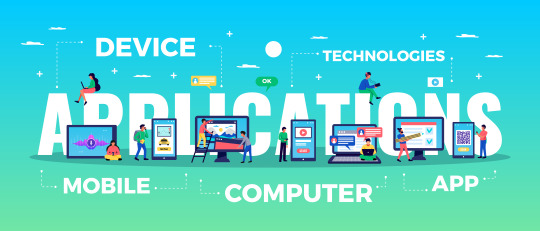
Introduction
In the age of digitalization, computers have become indispensable in every field—be it business, education, healthcare, communication, or entertainment. As technology continues to evolve, the demand for skilled IT professionals who can innovate, manage, and implement computer-based solutions is soaring. The Bachelor of Computer Applications (BCA) program is one such undergraduate course designed to build future-ready IT experts. It equips students with essential knowledge of software, hardware, networks, databases, and digital systems that are at the core of today’s information age.
The BCA course is structured to nurture creative problem-solvers and technical thinkers who can design and develop robust software applications. What sets BCA apart is its balance of theoretical grounding and practical training. It is particularly well-suited for students who have an interest in coding, app development, data analytics, and web technology. Over three years, learners gain a deep understanding of computer systems and gain exposure to real-time projects, preparing them to thrive in a variety of technology-driven industries.
Key Points:
BCA is a 3-year undergraduate degree in Computer Applications.
It prepares students for roles in IT, software development, and tech support.
The course is ideal for students interested in programming, app development, and digital technology.
Practical exposure through projects, internships, and lab work is a major highlight.
What is BCA?
The Bachelor of Computer Applications (BCA) is a specialized undergraduate program designed for individuals who want to build a strong foundation in the world of computer applications. Unlike engineering courses that delve deep into hardware and mathematical theories, BCA focuses more on application development, programming logic, and practical IT skills. It covers a wide spectrum of topics such as coding languages, data handling, system design, internet technologies, and cybersecurity.
Students enrolled in a BCA program receive comprehensive training in both the conceptual and functional areas of IT. The curriculum typically includes languages like C, C++, Java, and Python; database management systems such as MySQL or Oracle; and topics like data structures, operating systems, networking, and software engineering. Some universities are also including modern subjects like AI, Machine Learning, and Blockchain to keep the course aligned with industry trends.
Key Learning Areas in BCA:
Programming (C, C++, Java, Python)
Database Management Systems (DBMS)
Software Engineering and System Analysis
Web Development and Mobile App Development
Data Structures and Algorithms
Operating Systems and Computer Networks
Emerging Technologies: AI, ML, Cloud, IoT, Cybersecurity
Eligibility & Admission Process
To apply for the BCA program, candidates must have completed their 10+2 (higher secondary) education from a recognized board. While some universities prefer students with a background in Mathematics or Computer Science, many institutions allow candidates from any stream—Arts, Commerce, or Science—to apply. The minimum percentage required usually ranges between 45% to 55%, depending on the college’s criteria.
The admission process varies by institution. Some colleges offer direct admission based on merit (Class 12 marks), while others conduct entrance examinations or interviews to evaluate a student's aptitude for the course. Well-known universities like Christ University, Symbiosis, and IPU have their own entrance tests and selection criteria. Online applications, document verification, and counseling rounds are also part of the typical admission workflow in most institutions.
Admission Highlights:
Minimum Qualification: 10+2 from a recognized board.
Streams accepted: Science, Commerce, or Arts (varies by institution).
Admission modes:
Merit-based (Class 12 scores)
Entrance tests (e.g., IPU CET, CUET, SUAT)
Personal Interviews or Group Discussions
Some universities also offer online/distance BCA programs.
Top Colleges and Universities Offering BCA
When it comes to pursuing BCA, choosing the right college plays a crucial role in shaping a student's academic journey and career prospects. India boasts several reputed institutions offering comprehensive BCA programs supported by industry-relevant curricula, experienced faculty, high-end computer labs, and placement assistance. Both government and private colleges offer the course, catering to students from different educational and financial backgrounds.
Some of the most renowned BCA colleges in India include Christ University (Bangalore), Symbiosis Institute (Pune), Loyola College (Chennai), Guru Gobind Singh Indraprastha University (Delhi), and Sharda University (Greater Noida). These colleges focus not only on academic excellence but also on personality development, communication skills, and entrepreneurial thinking. Many have active placement cells that connect students with recruiters from top tech companies.
Top Institutions for BCA:
Christ University, Bangalore
Symbiosis Institute of Computer Studies & Research, Pune
Loyola College, Chennai
Guru Gobind Singh Indraprastha University (GGSIPU), Delhi
Sharda University, Greater Noida
Amity University, Noida
Madras Christian College (MCC), Chennai
Chandigarh University, Punjab
Career Opportunities After BCA
The BCA degree opens the door to a multitude of career options in India and abroad. Graduates can step into the workforce immediately after completing the program or opt for further studies such as MCA (Master of Computer Applications) or MBA in Information Technology to enhance their credentials. With businesses relying more on digital tools and automation, BCA graduates are valued for their ability to design software, troubleshoot systems, manage IT services, and create digital solutions for business operations.
Career paths after BCA are incredibly diverse. Graduates can work in software development, mobile application development, UI/UX design, web development, system administration, technical support, cybersecurity, and more. Companies such as TCS, Infosys, Wipro, IBM, Capgemini, Cognizant, and even global tech firms actively hire BCA graduates. Additionally, freelancing, entrepreneurship, and remote work opportunities have become more accessible than ever, allowing BCA holders to work flexibly from any part of the world.
Career Options After BCA:
Software Developer / Engineer
Web Developer / Full Stack Developer
Mobile App Developer (Android/iOS)
Database Administrator (DBA)
System Analyst / Network Administrator
Cybersecurity Analyst
Cloud Computing Specialist
Technical Support Engineer
UI/UX Designer
Data Analyst or Business Analyst
Industries Hiring BCA Graduates:
IT and Software Services
E-Commerce and Retail
FinTech and Banking
Healthcare IT
Digital Media and Gaming
EdTech and eLearning
Government & Public Sector IT Projects
1 note
·
View note